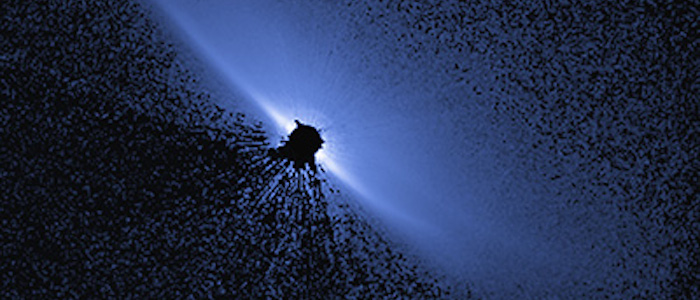
Contact Information
Astronomy Department96 Foss Hill Drive
Van Vleck Observatory 101
Wesleyan University
Middletown, CT 06459
(860) 685-3669 (office)
(860) 685-2131 (fax)
sredfield@wesleyan.edu
Fortuitously Aligned Planetary Disks
As I expanded my research from the interstellar medium to exoplanetary atmospheres, I discovered the interesting field of debris disks. In my ISM observations, at times, I would find stars that showed gas absorption at the stellar rest frame that would change from week to week (β Pic is the most spectacular example). This absorption arises from debris disks, which from the radio perspective are considered devoid of gas, but when viewed edge-on, show gas absorption in optical and UV spectral lines. Of course, these edge-on debris disks evenutally become edge-on planetary systems, which may exhibit planetary transits. One of my favorite systems is HD32297. I learned of the system from a paper that used HST observations of HD32297 in scattered light and discovered that the disk was almost edge-on. On my subsequent observing trip to McDonald Observatory, I observed HD32297 and several neighboring stars, and identified a clear gas absorption signature (see below; Redfield 2007).
In the figure above, there does appear to be some variation over the course of the year, but perhaps even more convincing is that the absorption detected at the stellar rest frame in HD32297 is not observed in any of the neighboring stars, indicating that it is not due to interstellar absorption. I am intrigued by the possibility of combining what we know from the radio (which mainly samples the outer disk) with these observations of UV and optical lines (which probaby sample the inner disk).
Recent Papers On This Topic:
1. Gas Absorption in the KH 15D
System: Further Evidence for Dust Settling in the Circumbinary
Disk Lawler, S.M., Herbst, W.,
Redfield, S., Hamilton, C.M., Johns-Krull, C.M., Winn, J.N.,
Johnson, J.A., & Mundt, R. 2010, ApJ, 711, 1297
We investigated the disk signature of KH 15D in high
resolution spectra of NaI. It required evaluating the ISM
contribution as well. This project was led by Samantha
Lawler, a Wesleyan MA student advised by Bill Herbst. It was
a joy to collaborate with my Wesleyan colleagues.
2. A Low-Mass H2 Component to
the AU Microscopii Circumstellar
Disk France, K., Roberge, A., Lupu,
R.E., Redfield, S., & Feldman, P.D. 2007, ApJ, 668,
1174
AU Mic is another interesting debris disk system. We used a detection
of H2 by FUSE to make an estimate of the
total molecular gas content in the debris disk.
3. Spitzer Limits On Dust
Emission and Optical Gas Absorption Variability Around Nearby
Stars with Edge-On Disk
Characteristics Redfield, S.,
Kessler-Silacci, J.E., & Cieza, L.A. 2007, ApJ, 661, 944
A project that used new Spitzer observations and a
ground-based monitoring campaign to measure the dust and gas
in several nearby debris disk candidates. While all systems
show short- and long-term variability in their optical lines,
none had detectable infrared excesses. So, we are not exactly
sure what is causing the variability, and these stars remain
interesting and perplexing targets.
4. A Dusty Disk Around
WD1150-153: Explaining the Metals in White Dwarfs by Accretion From
the Interstellar Medium Versus Debris
Disks Kilic, M., & Redfield, S. 2007, ApJ,
660, 641
White dwarfs are interesting hosts of debris disks because it implies
that there is planetary material around these old stellar remnants.
This work discovered a debris disk around a white dwarf by detecting
an excess of emission in the infrared. We explored the possibility of
accretion from the interstellar medium and asserted that it could not
explain the observed properties, and instead a debris disk could
account for the
accretion and pollution of the host white dwarf star.
5. Gas Phase Absorption by
the Edge-on Debris Disk Surrounding
HD32297 Redfield, S. 2007, ApJL, 656,
L97
Inspired by HST observations in scattered light that this
debris disk was almost exactly edge-on (like β Pic), I searched
for gas absorption from the disk. I found absorption at the stellar
rest velocity that was not seen in any neighboring sight lines,
confirming that it was not due to the interstellar medium.
6. Rapid Dissipation of
Primordial Gas from the AU Microscopii Debris
Disk Roberge, A., Weinberger, A.J., Redfield,
S., & Feldman, P.D. 2005, ApJL, 626, L105
We looked at H2 in the far-ultraviolet to estimate the
amount of gas in the AU Mic disk. These UV observations are
significantly more sensitive than the radio observations of CO and are
able to put more stringent constraints on the amount of gas in this disk.
